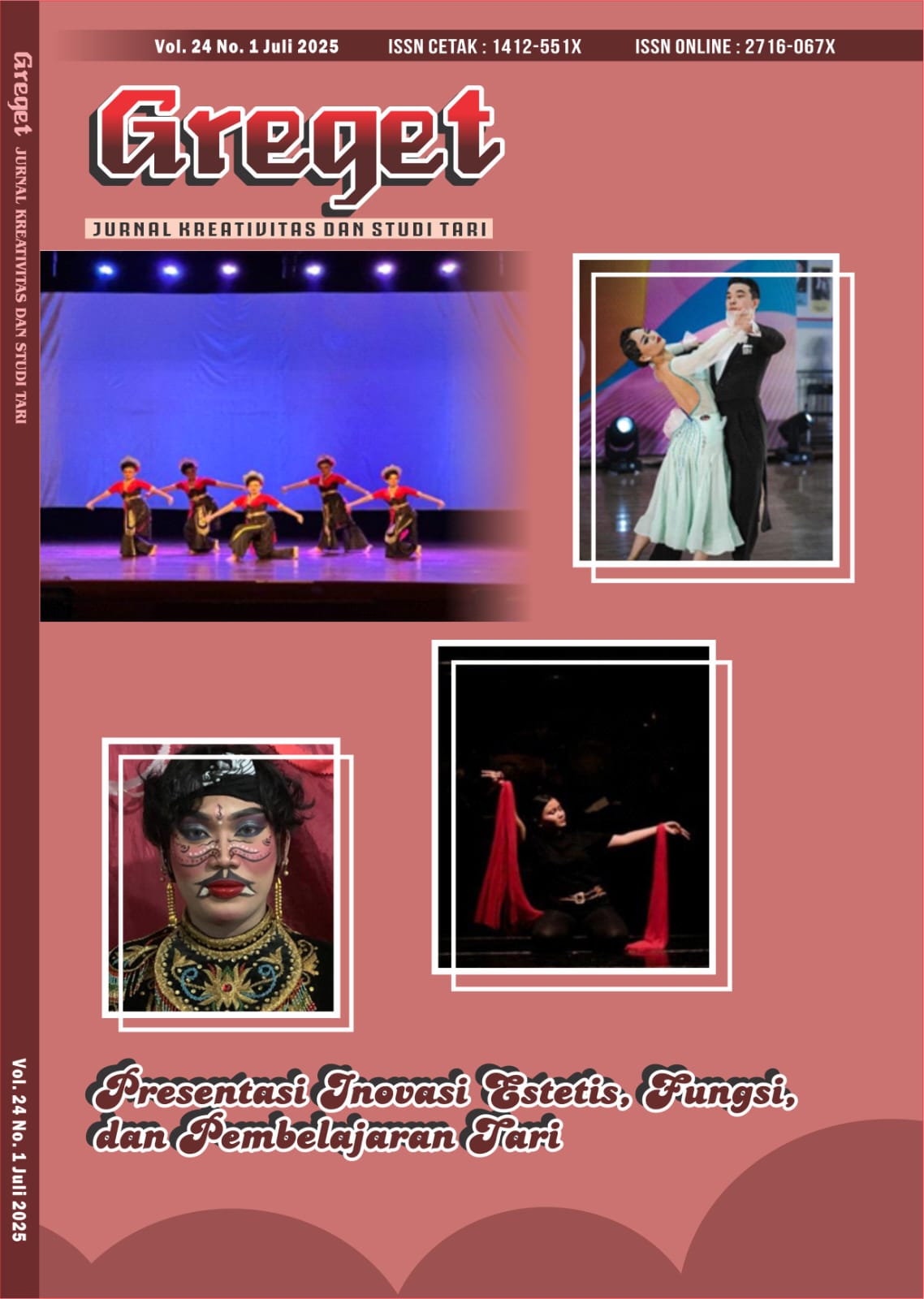KEPENARIAN ADI PUTRA CAHYA NUGRAHA DALAM TARI NGREMA BOLET JOMBANGAN
Main Article Content
Abstract
This research explores two main issues related to the form, technique, and performance quality of Adi Putra Cahya Nugraha in the Ngrema Bolet Jombangan dance: (1) the formal structure of the Ngrema Bolet Jombangan dance, and (2) the characteristics of Adi Putra Cahya Nugraha’s performance in terms of dance technique and expression. The study is grounded in the theoretical perspectives of Alma M. Hawkins on dance form, Sumandiyo Hadi’s theories of form and technique, and Tri Broto Wibisono’s concept of asisapapongolati. Using a qualitative research methodology with a choreographic approach, data were collected through field observation, interviews, and documentation. The findings reveal that the Ngrema Bolet Jombangan dance is a traditional folk dance with a warrior theme, performed in solo, duet, or group formations. Its structure consists of four main sections: (A) Ajon-ajon (opening), solah kanuragan, and isen; (B) Solah kridha and solah busana; (C) Solah budhalan; and (D) Pungkasan (closing). Adi Putra Cahya Nugraha, as the pengreman (lead dancer), demonstrates refined technical abilities and expressive qualities consistent with the principles of asisapapongolati. His dance practice incorporates both ritualistic and technical preparation, including nyebeng, nyajen, and gladen. Additionally, Adi showcases a personal stylistic identity through specific movement techniques such as adeg tanjak, saduk sampur, selentik sampur, and gantungan jaranan. This study contributes to the understanding of individual interpretation within traditional dance forms and highlights the role of personal style in sustaining and innovating cultural performance practices.
Downloads
Article Details

This work is licensed under a Creative Commons Attribution-ShareAlike 4.0 International License.
Copyright
Authors who publish with GREGET agrees to the following terms:
- Authors retain copyright and grant the journal right of first publication with the work simultaneously licensed under a Creative Commons Attribution-ShareAlike 4.0 (CC BY-SA 4.0) that allows others to share the work with an acknowledgment of the work's authorship and initial publication in this journal.
- Authors are able to enter into separate, additional contractual arrangements for the non-exclusive distribution of the journal's published version of the work (e.g., post it to an institutional repository or publish it in a book), with an acknowledgment of its initial publication in this journal.
- Authors are permitted and encouraged to post their work online (e.g., in institutional repositories or on their website) prior to and during the submission process, as it can lead to productive exchanges, as well as earlier and greater citation of published work.
References
Apriliani, U., & Wilujeng, B. Y. (2020). Bentuk dan Makna Pada Tata Rias Busana serta Aksesoris Tari Remo Jombangan. Jurnal Tata Rias, 9(1), 97–106.
Hadi, Y. S. (2003). Aspek-Aspek Dasar Koreografi Kelompok. Yogyakarta: Manthili.
Hadi, Y. S. (2007). Kajian Tari Teks dan Kontes (Vol. 1). Yogyakarta: Pustaka Book Publisher bekerjasama dengan ISI Yogyakarta.
Hadi, Y. S. (2012). Koreografi: Bentuk-Teknik-Isi (1st ed., Vol. 2). Yogyakarta: Cipta Media.
Jaeni. (2012). Komunikasi Estetik dalam Seni Pertunjukan Teater Rakyat Sandiwara Cirebon. Panggung. 22(2), 160-168.
Jannah, A. F. dan Sulastuti, K. (2024). Interpretasi pada Tokoh Srikandi Dalam Tari Srikandi Cakilsusunan Didik Bambang Wahyudi. Greget. 23(2). 185-199.
Mariati, P. (2014). Kreativitas Ali Markasa dalam Penciptaan Tari Ngremo Jombangan. [Tesis Pasca Sarjana Institut Seni Indonesia Surakarta].
Mariati, P., & Prihatini, N. S. (2015). Konsepsional Ali Markasa dalam Penciptaan Tari Ngremo Jombangan. Gelar. 13(1), 32–38.
Prabowo, W. S. (1990). Bedhaya Anglirmendung Monumen Perjuangan Mangkunagara 1, 1757-1988. [Tesis S-2 Universitas Gadjah Mada Yogyakarta].
Pramutomo, R.M. (2008). Etnokoreologi Nusantara (Batasan Kajian, Sistimatika, dan Aplikasi Keilmuannya. Surakarta: ISI Perss
Pramutomo, R.M. (2009). Tari, Seremonial, dan Politik Kolonial (I) ‘Pseudoabsolutisme’ Pasca Perjanjian Giyanti 1755 dan Konteks Perkembangan Tari Jawa Gaya Yogyakarta. Surakarta: ISI Perss.
Prasetyo, Aris. (2024). Kepenarian Sri Wardoyo dalam Tari Gambiranom. Greget. 23(2), 117-125.
Sari, R. T. A., & Wahyudi. (2017). Rekonstruksi Gerak pada Tari Remo Tawi Jombang. Joged. 10(2), 577-589.
Sulastuti, I. K. (2006). Notasi Laban I. Surakarta: ISI Perss.
Sumaryono. (2011). Antopologi Tari dalam Perspektif Indonesia. Yogyakarta: Media Kreativa.
Wahyudiyanto. (2006). Karakteristik Ragam Gerak dan Tata Rias-Busana Tari Ngremo sebagai Wujud Presentasi Simbolis Sosio Kultural. Imaji. 4(2), 124-144.
Wahyudiyanto. (2008). Pengetahuan Tari. Surakarta: ISI Press.
Wahyudiyanto. (2020). Tari Ngremo: Sejarah, Teknik, Kinestetik, dan Bentuk Estetik. Surabaya: PT. Revka Media.
Wahyudiyanto. (2021). Tari Ekspresi Manusia dalam Kebudayaan: (Urip, Urup, Urap, Nguripi). Surabaya: PT. Revka Media.
Yunita, H. D. (2019). Kepenarian Rusini dalam Tari Bedhaya Pangkur. [Skripsi Institut Seni Indonesia Surakarta].
